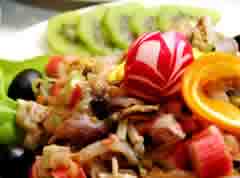- | Food & Drink >> Jedlo a pitie > >> Varenie a pečenie >> kuchynský riad
What is the background research of color changing milk?
Natural Pigments:
Certain fruits, vegetables, or herbs can be used to naturally change the color of milk. Napríklad:
1. Red Color :Beets, raspberries, or strawberries contain natural red pigments like anthocyanins that can turn milk pink or red.
2. Yellow Color :Turmeric or saffron can impart a yellow color to milk due to their curcumin content.
3. Green Color :Spinach, green tea, or spirulina can add a green hue to milk due to chlorophyll or other pigments.
4. Blue Color :Blueberries or butterfly pea flowers contain blue pigments called anthocyanins that can turn milk blue.
Food Coloring:
Edible food coloring can also be added to milk to achieve various color changes. However, it's essential to use food-grade coloring and follow manufacturer guidelines to ensure safety.
Chemical Reactions:
Some chemical reactions can cause milk to change color. One common example is the addition of baking soda (sodium bicarbonate) to milk. The reaction between baking soda and the lactic acid in milk produces carbon dioxide gas, causing the milk to foam and turn slightly yellow or brown.
pH-Sensitive Indicators:
Certain compounds called pH indicators change color when exposed to different pH levels. By adding a pH indicator to milk and adjusting its pH, it's possible to achieve color changes. For instance, adding red cabbage juice, which contains anthocyanins, can turn milk pink at a neutral pH, purple at a slightly acidic pH, and green at a more acidic pH.
It's important to note that while these methods can produce visually appealing color changes, altering the natural properties or flavor of milk should be considered carefully. Additionally, some color-changing milk creations may not be suitable for consumption and should be used for visual demonstrations only.
kuchynský riad
- Môžete použiť sklo Pan variť pečienka
- Čo zanechávajú muchy biele po pristátí na jedle?
- Čo môžem použiť na čistenie termohrnca Môj má v sebe…
- Môžete nechať strieborný príbor v plechovke v chladnič…
- Koľko oleja je v balíčku lupienkov?
- Pokyny pre starostlivosť o liaty hliník servisných misiek…
- Ako mumifikujete jablko?
- Aké opatrenia by sa mali prijať počas fermentácie, aby s…
- ? Čo je Kubbe Nástavec pre mlynček na mäso
- Ako variť rebrá dieťa späť S Ronco Rotisserie
kuchynský riad
- pečenie
- pečenie Základy
- pečenie Techniky
- varenie techniky
- kuchynské potreby
- kuchynský riad
- jednoduché recepty
- zelená
- Vytvárajte & Špajza
- korenie




